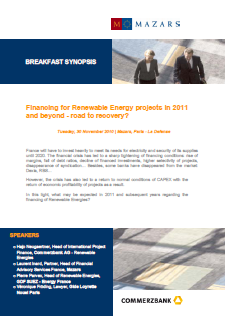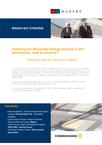Financing for Renewable Energy projects in 2011 and beyond - road to recovery?
Financing for Renewable Energy projects
However, the crisis has also led to a return to normal conditions of CAPEX with the return of economic profitability of projects as a result.
In this light, what may be expected in 2011 and subsequent years regarding the financing of Renewable Energies?
“it has led to a sharp tightening of financing conditions, characterised by rising margins, declining debt ratios, decline of financed investments, higher selectivity of projects, and disappearance of syndication”
France anticipates that its energy mix will contain 23% of renewable energies by 2020. This means that the production of wind energy will have to increase from 5,000 MW today to 25,000 MW, that solar energy will have to increase from 600 MW to 5,400 MW, and that biomass energy will have to increase to 2,300 MW from today’s non-existent levels.
Germany had even more ambitious environmental targets, and was planning for 60% of its total energy production and 80% of its electricity position to come from renewable energies by 2050. These objectives stem from the need to satisfy increased consumption levels, address the peak oil situation, and fight global warning.
In the lead up to 2020, France will have to invest heavily to meet its needs for electricity and security of supply. In this context, the impact of the financial crisis had to be considered.
On the down side, it has led to a sharp tightening of financing conditions, characterised by rising margins, declining debt ratios, decline of financed investments, higher selectivity of projects, and disappearance of syndication. In addition, certain banks such as Dexia or RBS have completely disappeared from the market.
On the more positive side, the crisis has led to the re-emergence of normal CAPEX conditions, resulting in a return to the economic profitability of projects.
In the light of these factors, what can be expected in 2011 and subsequent years regarding the financing of renewable energies ? In particular, in terms of financing, legal and valuation aspects applicable to these projects.
This publication is only available in English


